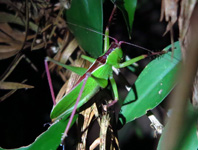Abstract
There are 29 species or subspecies in genus Hexacentrus occurring in Asia, Africa and Australia. Because of its similar appearance, it is not easy to distinguish them by traditional methods. In this study, we collected samples and sequenced COI genes from wide range. By reconstructing the gene tree, we found one new species, H. formosanus Chen et He sp. nov., from Taiwan. The new species is similar to H. expansus or H. inflatissimus, but differs from the former in male Cu2 vein of left tegmina curved and slender, and spectrum of male left tegmina slender and subsquare; differs from the later by body size smaller and female tegmina narrow and short. The type specimens are deposited in National Museum of Natural Science, Taichung, Taiwan (NMNS). H. japonicus hareyamai is treated as species level, H. hareyamai stat. nov.
References
Bey-Bienko, G.Y. (1962) Results of the Chinese-Soviet zoological-botanical expeditions to south-western China 1955–1957. New or less known Tettigonioidea (Orthoptera) from Szechuan and Yunnan. Trudy Zoologitscheskogo Instituta, Akademiia Nauk SSSR, Leningrad [Proceedings of the Zoological Institute, USSR Academy of Sciences, Leningrad], 30, 110–138.
Cigliano, M.M., Braun, H., David, C.E. & Otte, D. (2020) Orthoptera Species File. Version 5.0/5.0. Available from: http://orthoptera.speciesfile.org/HomePage/Orthoptera/HomePage.aspx (accessed 11 October 2020)
Furukawa, H. (1941) A critical note on some species of Hexacentrus (Orthopt.). Zoological Magazine, 53 (7), 367–370.
Gorochov, A.V. & Warchałowska-Śliwa, E. (1999) A new species of the genus Hexacentrus (Orthoptera, Tettigoniidae) from Vietnam and its karyotypic features. Acta Zoologica Cracoviensia, 42, 265–269.
Guo, H.-F., Guan, B., Shi, F.-M. & Zhou, Z.-J. (2016) DNA Barcoding of genus Hexacentrus in China reveals cryptic diversity within Hexacentrus japonicus (Orthoptera, Tettigoniidae). Zookeys, 596, 53–63.
https://doi.org/10.3897/zookeys.596.8669
Hebard, M. (1922) Studies in Malayan, Melanesian and Australian Tettigoniidae (Orthoptera). In: William, J.F. (Ed.), Proceedings of the Academy of Natural Sciences of Philadelphia. Vol. 74. Academy of Natural Sciences of Philadelphia, Philadelphia, Pennsylvania, pp. 121–299.
Ichikawa, A., Ito, F., Kano, Y., Kawai, M., Tominaga, O. & Murai, T. (2006) Orthoptera of the Japanese Archipelago in color. Hokkaido University Press, Sapporo, 687 pp.
Karny H.H. (1907) Abhandlungen der K.K. Zool.-Botan. Gesellschaft in Wien. Zoologisch-Botanische Gesellschaft in Österreich, Wien, 111 pp.
Kato, M. (1932) Three Colour Illustrated Insects of Japan. Fascicle 1: Dermaptera and Orthoptera. Koseikaku, Tokyo, 122 pp.
Kim, S.Y., Kang, T.H., Kim, T.W. & Seo, H.Y. (2020) DNA barcoding of the South Korean Tettigoniidae (Orthoptera) using collection specimens reveals three potential species complexes. Entomological Research, 50, 267–281.
https://doi.org/10.1111/1748-5967.12433
Kirby, W.F. (1906) Orthoptera Saltatoria, Locustidae vel Acridiidae. Vol. 2. British Museum (Natural History), London, 287 pp.
Kumar, S., Stecher, G. & Tamura, K. (2016) MEGA7: Molecular evolutionary genetics analysis Version 7.0 for bigger datasets. Molecular Biology and Evolution, 33, 1870–1874.
Matsumura, S. (1931) 6000 illustrated insects of Japan-Empire. Toko Shoin, Tokyo, 1689 pp.
Matsumura, S. & Shiraki, T. (1908) Locustiden Japans. Journal of the College of Agriculture, Tohoku Imperial University, 3 (1), 1–80.
Nguyen, L.T., Schmidt, H.A., von Haeseler, A. & Minh, B.Q. (2014) IQ-TREE: a fast and effective stochastic algorithm for estimating maximum-likelihood phylogenies. Molecular Biology and Evolution, 32, 268–274.
https://doi.org/10.1093/molbev/msu300
Pan, C.-Y., Hu, J., Zhang, X. & Huang, Y. (2006) The DNA barcoding application of mtDNA COI gene in seven species of Catantopidae (Orthoptera). Entomotaxonomia, 28, 103–110.
Ronquist, F. & Huelsenbeck, J.P. (2003) MrBayes 3: Bayesian phylogenetic inference under mixed models. Bioinformatics, 19, 1572–1574.
https://doi.org/10.1093/bioinformatics/btg180
Walker, F. (1869) Catalogue of the Specimens of Dermaptera Saltatoria in the Collection of the British Museum. Vol. 2. British museum, London, 282 pp.
Wang, J.-F., Shi, F.-M. (2005) A taxonomic review of the genus Hexacenthrus Serville from China (Orthoptera: Conocephalidae). Acta Entomologica Sinica, 48 (2), 242–246.
Warchałowska-Śliwa, E. (1998) Karyotype characteristics of katydid Orthopterans (Ensifera, Tettigoniidae), and remarks on their evolution at different taxonomic levels. Folia Biologica, 46, 143–176.
Zhang, D., Gao, F., Jakovlić, I., Zou, H., Zhang, J., Li, W.X. & Wang, G.T. (2020) PhyloSuite: an integrated and scalable desktop platform for streamlined molecular sequence data management and evolutionary phylogenetics studies. Molecular Ecology Resources, 20 (1), 348–355.
https://doi.org/10.1111/1755-0998.13096


